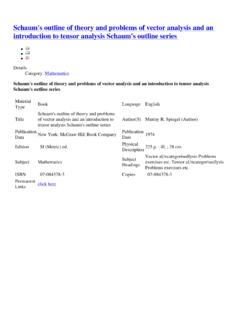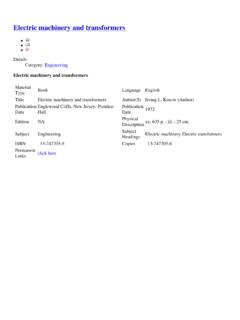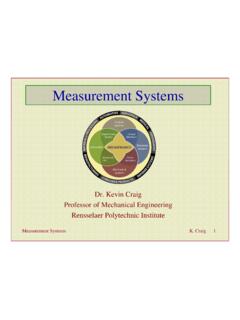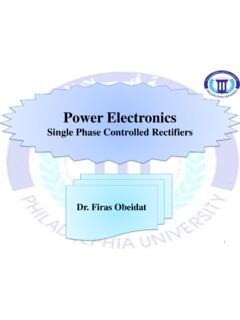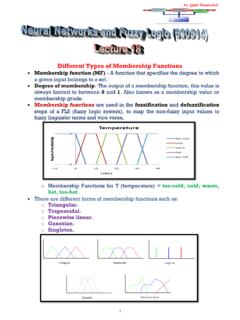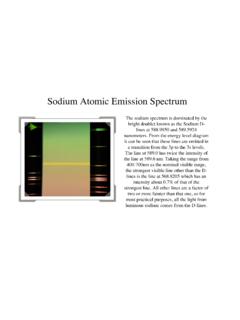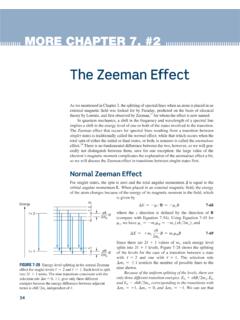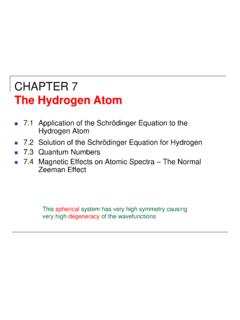Transcription of Basic Principles of Atomic Absorption and Atomic Emission ...
1 1 Basic Principles of Atomic Absorption and Atomic Emission Spectroscopy 2 Source Wavelength Selector Sample Detector Signal Processor Readout P Flame Atomic Emission Spectrometer 3 Flame Atomic Emission Spectrometer 4 Emission Techniques Type Method of Atomization Radiation Source Arc sample heated in an sample electric arc (4000-5000oC) Spark sample excited in a sample high voltage spark Flame sample solution sample aspirated into a flame (1700 3200 oC) Argon sample heated in an sample plasma argon plasma (4000-6000oC) 5 Flame and Plasma Emission Spectroscopy are based upon those particles that are electronically excited in the medium. The Functions of Flame and Plasma convert the constituents of liquid sample into the vapor state. 2. To decompose the constituents into atoms or simple molecules: M+ + e- (from flame) -> M + hn 3.
2 To electronically excite a fraction of the resulting Atomic or molecular species M -> M* Emission Spectroscopy 6 Measure the intensity of emitted radiation Emission Spectroscopy Gro und StateExc ited StateEmits Special Electromagnetic Radiation7 8 Argon Inductively Coupled Plasma as an atomization source for Emission spectroscopy 9 10 Flame techniques are limited to alkali (Li, Na, K, Cs, Rb) and some alkaline earth metals (Ca and Mg) More energetic sources are used for more elements specially transition elements simultaneous multielement analysis since spectra od dozen of elements can be recorded simultaneously Interelement interference is eliminated Liquids and solids Why plasma source or other high energetic sources? 11 Advantages and disadvantages of Emission spectrometry Advantages rapid Multielement (limited for alkali and some alkaline earth metals ICP-AES has become the technique of choice for metals analysis.)
3 Disadvantages initial cost of ICP instrumentation continuing cost of operation (Ar required) 12 Flame Atomic Absorption Spectrometer Source Wavelength Selector Sample Detector Signal Processor Readout P Po Chopper 13 Flame Atomic Absorption Spectrometer T 14 Atomization Techniques Type Method of Atomization Radiation Source Atomic sample solution aspirated HCL (flame) into a flame Atomic sample solution evaporated HCL (nonflame) & ignited (2000 -3000 oC) (Electrothermal) Hydride Vapor hydride generated HCL generation Cold vapor Cold vapor generated (Hg) HCL 15 Advantages and disadvantages of Atomic Absorption Advantages sensitive (GFAA) selective Disadvantages intended for metallic/metalloid Atomic species, not nonmetals or intact molecular species lamps - one element at a time not easy for solids calibration curves nonlinear above A = more costly and less widely applicable than UV vis matrix effects - easy for some metals to be masked 16 17 Flame Fluorescence Spectrometer Source Wavelength Selector Sample Detector Signal Processor Readout P Po 90o 18 Fluorescence Techniques Type Method of Atomization Radiation Source Atomic sample soln.
4 Aspirated sample (flame) into a flame Atomic sample soln. evaporated sample (nonflame) & ignited x-ray none required sample fluoresence 19 Processes that take place in flame or plasma T 1 20 Flames Regions in Flame Temperature Profile 21 22 23 24 25 26 27 Flameless atomization Electrothermal atomization Graphite furnace atomization 28 29 30 31 Why do we use a temperature program in flameless AA? 32 Why do we use an inert gas with Flameless atomization? 33 Light source used for AA What light source do we use with AA? Would it be a continuous light source or a line light source? A line light source is used for AA 34 T 2 35 36 How does the line source provide a single wavelenght? T3 37 38 39 AA spectrophotometer 40 41 42 43 44 Flame Emission -> it measures the radiation emitted by the excited atoms that is related to concentration.
5 Atomic Absorption -> it measures the radiation absorbed by the unexcited atoms that are determined. Atomic Absorption depends only upon the number of unexcited atoms, the Absorption intensity is not directly affected by the temperature of the flame. The flame Emission intensity in contrast, being dependent upon the number of excited atoms, is greatly influenced by temperature variations. Relationship Between Atomic Absorption and Flame Emission Spectroscopy 45 Measured signal and analytical concentration Emission Signal = Intensity of Emission = KNf = K Na =K C Nf = number of free atoms in flame Na = number of absorbing atoms in flame C = concentration of analyte in the sample K, K` and K depend upon: Rate of aspiration (nebulizer) Efficiency of aspiration (evaporation efficiency) Flow rate of solution Solution concentration Flow rate of unburnt gas into flame Efficiency of atomization ( effect of chemical environment).
6 This depends upon Droplet size Sample flow rate Refractory oxide formation Ratio of fuel/oxygen in flame Temperature effect (choice of flame temperature) 46 2. Atomic Absorption Signal = I absorbed = Absorbance = A = k l C For the measurement to be reliable k must be constant; k should not change when a change in matrix or flame type takes place. K depends upon same factors as those for the Atomic Emission spectroscopy 47 Background and Background Correction 48 Definition Sources of Background Background correction: Blank correction method Two-line correction method Continuous source correction method zeeman effect correction method 49 What is a background? It is the signal observed when the element sought is absent The light at a specific wavelength (Analyte wavelength) is attenuated by the effect of flame components or matrix components in the sample Thus measured absorbance and analyte concentrations are too high If problem from flame, blank aspiration will correct for it It is more serious at short wavelengths (< 430 nm) and with graphite furnace 50 Sources of Background in Atomic Absorption 1.
7 Absorption by flame itself (Serious at below 220 nm; , As, Se, Zn ) Water blank can compensate for this flame Absorption In flame Absorption , background interference is insignificant at > 230 nm 51 2. Absorption by concomitant molecular species originating from the matrix like NaX or solvents containing X (halogen) like CCl4. Halides absorb at < 300 nm 3. Scattering of radiation from the particulate material in the flame Particulate material: Unevaporated droplets; unevaporated refractory salt particles Scattering is more serious at short 2 and 3 are most common with electrothermal atomizer 52 Specific Applications Require background correction 1. Graphite furnace determination of low concentrations of an element in the presence of high concentrations of dissolved salts 3. Flame analysis where sample matrix may show molecular Absorption at of the resonance line 4.
8 Flame determination of an element at where flame Absorption is high 53 Background correction methods 1. Using a blank Measure the absorbance of the metal resonance line by both flame & blank (flame system) Measure the absorbance of the metal resonance line by sample and flame system (flame + blank) A is the difference 54 The main two methods used for background correction: source correction method effect correction method These two methods are based on the fact that Atomic bands are very narrow Background bands are molecular in nature thus they are broad bands 55 2. The continuous-source correction method This method is an available option with most instruments Deuterium lamp is used in conjunction with the HCL lamp The two lamps are observed by detector alternatively in time Background usually absorb radiation from D2 lamp and HCL Absorption of the analyte from D2 lamp is negligible The lamps may be pulsed at different frequencies, thus the signal processing electronics can distinguish and process separate Absorption signals Thus Acorrected = A HCL - AD2 56 The continuous-source correction method Chopper 57 58 Background correction by continuous source correction method HCL HCL HCL 59 60 Disadvantages of the continuous source correction method Correction may degrade detection limit.
9 The current of HCL is reduced to match the D2 lamp The correction may be in error if the background s (sample and standards) are not the same Alignment of the two sources to pass through the same area of atomizer is tedious Beam splitter reduces the intensity of radiation which may affect the limit of detection Additional light source and electronics are needed 61 zeeman effect correction method 62 zeeman effect correction method 63 Under the magnetic field, Atomic spectral line (emitted or absorbed) splits into three or more polarized components Two components will be displaced at equal wavelength intervals higher and lower than the original line. The original line is polarized in plane parallel to the magnetic field and the other lines are polarized perpendicular to the magnetic field The original line is absorbed by both background and analyte. However, the other lines are absorbed by background only The signal corresponding to the analyte is the difference 64 Advantages of zeeman method Only a single lamp is required Problems of alignment of two beams is eliminated It provides more accurate correction for background than other methods because the background absorbance is measured at or very near the wavelength that the analyte absorbance is measured 65 Disadvantages of zeeman method The implementation is rather complex and expensive The original and the split bands may overlap causing an increase in the background signal This causes a curvature in the calibration curve The instrument is bulky because of the magnet Spectral lines for some elements may undergo more complex splitting.
10 Thus sensitivity will be reduced (It gave good results for 44 elements) It is more difficult to engineer with flames 66 Source self reversal background correction method It is based on self-reversal of the HCL spectral lines at high current At high current, many free atoms are generated causing an increase in the number of unexcited atoms that absorb the center of the emitted line causing the self reversal Specially good for correcting for high molecular Absorption for that by phosphate on Se and As A total is measure 67 Hollow cathode lamps normally operate at currents of 3-15 mA. If the applied power is raised to several hundred mA, they exhibit a phenomenon called self-reversal. This giant pulse of current changes the nature of the analyte Absorption line so it will only measure the background absorbance. Atotal is measured during the low current period.

